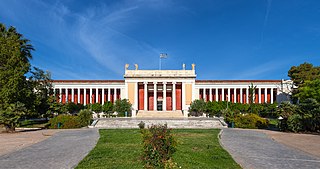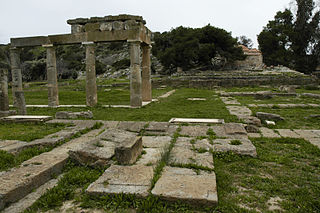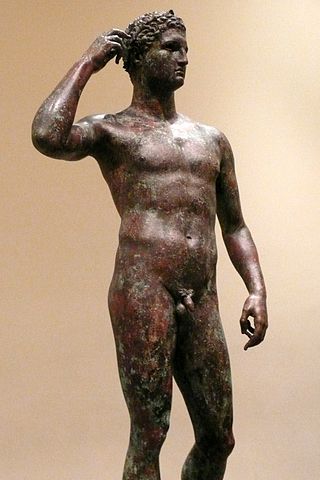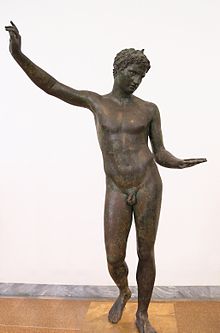
Maritime archaeology is a discipline within archaeology as a whole that specifically studies human interaction with the sea, lakes and rivers through the study of associated physical remains, be they vessels, shore-side facilities, port-related structures, cargoes, human remains and submerged landscapes. A specialty within maritime archaeology is nautical archaeology, which studies ship construction and use.

Praxiteles of Athens, the son of Cephisodotus the Elder, was the most renowned of the Attica sculptors of the 4th century BC. He was the first to sculpt the nude female form in a life-size statue. While no indubitably attributable sculpture by Praxiteles is extant, numerous copies of his works have survived; several authors, including Pliny the Elder, wrote of his works; and coins engraved with silhouettes of his various famous statuary types from the period still exist.

The shipwreck of Mahdia was found by Greek sponge fishermen off the coast of Tunisia in June 1907. The shipwreck near the modern town of Mahdia is dated to between 80 and 60 BC.

The sculpture of ancient Greece is the main surviving type of fine ancient Greek art as, with the exception of painted ancient Greek pottery, almost no ancient Greek painting survives. Modern scholarship identifies three major stages in monumental sculpture in bronze and stone: the Archaic, Classical (480–323) and Hellenistic. At all periods there were great numbers of Greek terracotta figurines and small sculptures in metal and other materials.

Artemisium or Artemision is a cape in northern Euboea, Greece. The hollow cast bronze statue of Zeus or Poseidon, known as the Artemision Bronze, was found off this cape in a sunken ship, as was the Jockey of Artemision, a bronze statue of a racehorse and its jockey.

Antikythera or Anticythera is a Greek island lying on the edge of the Aegean Sea, between Crete and Peloponnese. In antiquity the island was known as Aigilia (Αἰγιλία). Since the 2011 local government reform, it is part of the municipality of Kythira island.

The National Archaeological Museum in Athens houses some of the most important artifacts from a variety of archaeological locations around Greece from prehistory to late antiquity. It is considered one of the greatest museums in the world and contains the richest collection of Greek Antiquity artifacts worldwide. It is situated in the Exarcheia area in central Athens between Epirus Street, Bouboulinas Street and Tositsas Street while its entrance is on the Patission Street adjacent to the historical building of the Athens Polytechnic university.

Brauron was one of the twelve cities of ancient Attica, but never mentioned as a deme, though it continued to exist down to the latest times. It was situated on or near the eastern coast of Attica, between Steiria and Halae Araphenides, near the river Erasinus. Brauron is celebrated on account of the worship of Artemis Brauronia, in whose honour a festival was celebrated in this place. This site includes the remains of a temple, a stoa, and a theatre, providing insights into the religious practices and social life of ancient Greece. Its significance as a religious and cultural site can be further understood through the exploration of its archeological remains and historical accounts.
The Antikythera wreck is a Roman-era shipwreck dating from the second quarter of the first century BC.

The Antikythera Ephebe, registered as: Bronze statue of a youth in the museum collections, is a bronze statue of a young man of languorous grace that was found in 1900 by sponge-divers in the area of the ancient Antikythera shipwreck off the island of Antikythera, Greece. It was the first of the series of Greek bronze sculptures that the Aegean and Mediterranean yielded up in the twentieth century which have fundamentally altered the modern view of ancient Greek sculpture. The wreck site, which is dated about 70–60 BC, also yielded the Antikythera mechanism, a characterful head of a Stoic philosopher, and a hoard of coins. The coins included a disproportionate quantity of Pergamene cistophoric tetradrachms and Ephesian coins, leading scholars to surmise that it had begun its journey on the Ionian coast, perhaps at Ephesus; none of its recovered cargo has been identified as from mainland Greece.

The Dancing Satyr of Mazara del Vallo is a fragmentary over-lifesize ancient Greek bronze statue, of Magna Graecia whose refinement and rapprochement with the manner of Praxiteles has made it a subject of discussion. It is an example of a dancing satyr, a sculptural archetype in Hellenistic and Roman art. Another well-known example is the Faun from the House of the Faun, Pompeii.

The Victorious Youth, Getty Bronze, also known as Atleta di Fano, or Lisippo di Fano, is a Greek bronze sculpture, made between 300 and 100 BC, in the collections of the J. Paul Getty Museum, Pacific Palisades, California. Many underwater bronzes have been discovered along the Aegean and Mediterranean coast; in 1900 sponge divers found the Antikythera Youth and the portrait head of a Stoic, at Antikythera, the standing Poseidon of Cape Artemision in 1926, the Croatian Apoxyomenos in 1996 and various bronzes until 1999. The Victorious Youth was found in the summer of 1964 in the sea off Fano on the Adriatic coast of Italy, snagged in the nets of an Italian fishing trawler. In the summer of 1977, The J. Paul Getty Museum purchased the bronze statue and it remains in the Getty Villa in Malibu, California. Bernard Ashmole, an archaeologist and art historian, was asked to inspect the sculpture by a Munich art dealer Heinz Herzer; he and other scholars attributed it to Lysippos, a prolific sculptor of Classical Greek art. The research and conservation of the Victorious Youth dates from the 1980s to the 1990s, and is based on studies in classical bronzes, and ancient Mediterranean specialists collaboration with the Getty Museum. The entire sculpture was cast in one piece; this casting technique is called the "lost wax" method; the sculpture was first created in clay with support to allow hot air to melt the wax creating a mold for molten bronze to be poured into, making a large bronze Victorious Youth. More recently, scholars have been more concerned with the original social context, such as where the sculpture was made, for what context and who he might be. Multiple interpretations of where the Youth was made and who the Youth is, are expressed in scholarly books by Jiri Frel, Paul Getty Museum curator, from 1973 to 1986, and Carol Mattusch, Professor of Art History at George Mason University specializing in Greek and Roman art with a focus in classical bronzes.

The Artemision Bronze is an ancient Greek sculpture that was recovered from the sea off Cape Artemision, in northern Euboea, Greece. According to most scholars, the bronze represents Zeus, the thunder-god and king of gods, though it has also been suggested it might represent Poseidon. The statue is slightly over lifesize at 2.09 meters, and would have held either a thunderbolt, if Zeus, or a trident if Poseidon. The empty eye-sockets were originally inset, probably with bone, as well as the eyebrows, the lips, and the nipples. The sculptor is unknown. The statue is a highlight of the collections in the National Archaeological Museum of Athens.

George Fletcher Bass was an American archaeologist. An early practitioner of underwater archaeology, he co-directed the first expedition to entirely excavate an ancient shipwreck at Cape Gelidonya in 1960 and founded the Institute of Nautical Archaeology in 1972.

The Archaeological Museum of Olympia is one of the principal museums of Greece, located in Olympia. It is overseen by the Ministry of Culture and Sports, and, as of 2009, is directed by Georgia Xatzi. When the original building was completed and opened in 1888, it was the first museum in Greece outside of Athens.

The Archaeological Museum of Piraeus contains mainly sculptures, discovered in Piraeus and in the area of the Attic coast from Bronze Age to Roman times,

The Resting Satyr or Leaning Satyr, also known as the Satyr anapauomenos is a statue type generally attributed to the ancient Greek sculptor Praxiteles. Some 115 examples of the type are known, of which the best known is in the Capitoline Museums.
The Dokos shipwreck is the oldest underwater shipwreck discovery known to archeologists. The wreck has been dated to the second Proto-Helladic period, 2700–2200 BC.

The Jockey of Artemision is a large Hellenistic bronze statue of a young boy riding a horse, dated to around 150–140 BC. It is a rare surviving original bronze statue from Ancient Greece and a rare example in Greek sculpture of a racehorse. Most ancient bronzes were melted down for their raw materials some time after creation, but this one was saved from destruction when it was lost in a shipwreck in antiquity, before being discovered in 1926. It may have been dedicated to the gods by a wealthy person to honour victories in horse races, probably in the single-horse race. The artist is unknown.

The Diana of Gabii is a statue of a woman in drapery which probably represents the goddess Artemis and is traditionally attributed to the sculptor Praxiteles. It became part of the Borghese collection and is now conserved in the Louvre with the inventory number Ma 529.



















